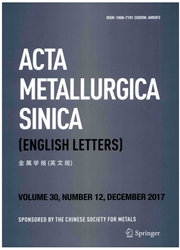

 中文摘要:
中文摘要:
Fe43M5Cr15Mo14C15B6Y2 (M=Mn,Co,Ni,and Cu in at.%)bulk metallic glasses(BMGs)are synthesized using the suction casting technique,and the glass-forming ability(GFA),microstructure,and thermal and magnetic properties of these glasses are extensively examined using X-ray diffraction,differential scanning calorimeter,and vibrating sample magnetometer techniques.Among the four BMG alloys,Fe43Ni5Cr15Mo14C15B6Y2 exhibits the lowest coercivity and the highest saturation magnetization,Curie temperature,effective magnetic moment,and GFA.By contrast,Fe43Mn5Cr15Mo14C15B6Y2 presents the poorest magnetic properties,such as the highest coercivity and the lowest saturation magnetization,Curie temperature,and effective magnetic moment.Fe43Cu5Cr15Mo14C15B6Y2 demonstrates the lowest thermal stability and GFA.The observed thermal,structural,and magnetic properties of these BMG alloys are discussed in terms of the kinetics of BMG synthesization and the formation of different ferromagnetic,ferrimagnetic,and antiferromagnetic phases.
 英文摘要:
英文摘要:
Fe43MsCra5Mo14C15B6Y2 (M = Mn, Co, Ni, and Cu in at.%) bulk metallic glasses (BMGs) are synthesized using the suction casting technique, and the glass-forming ability (GFA), microstructure, and thermal and magnetic properties of these glasses are extensively examined using X-ray diffraction, differential scanning calorimeter, and vibrating sample magnetometer techniques. Among the four BMG alloys, Fe43NisCr15Mo14C15B6Y2 exhibits the lowest coercivity and the highest saturation magnetization, Curie temperature, effective magnetic moment, and GFA. By contrast, Fe43MnsCrlsMo14C15B6Y2 presents the poorest magnetic properties, such as the highest coercivity and the lowest saturation magnetization, Curie temperature, and effective magnetic moment. Fe43Cu5Cr15MolaC15B6Y2 demonstrates the lowest thermal stability and GFA. The observed thermal, structural, and magnetic properties of these BMG alloys are discussed in terms of the kinetics of BMG synthesization and the formation of different ferromagnetic, ferrimagnetic, and antiferromagnetic phases.
 同期刊论文项目
同期刊论文项目
 同项目期刊论文
同项目期刊论文
 期刊信息
期刊信息
